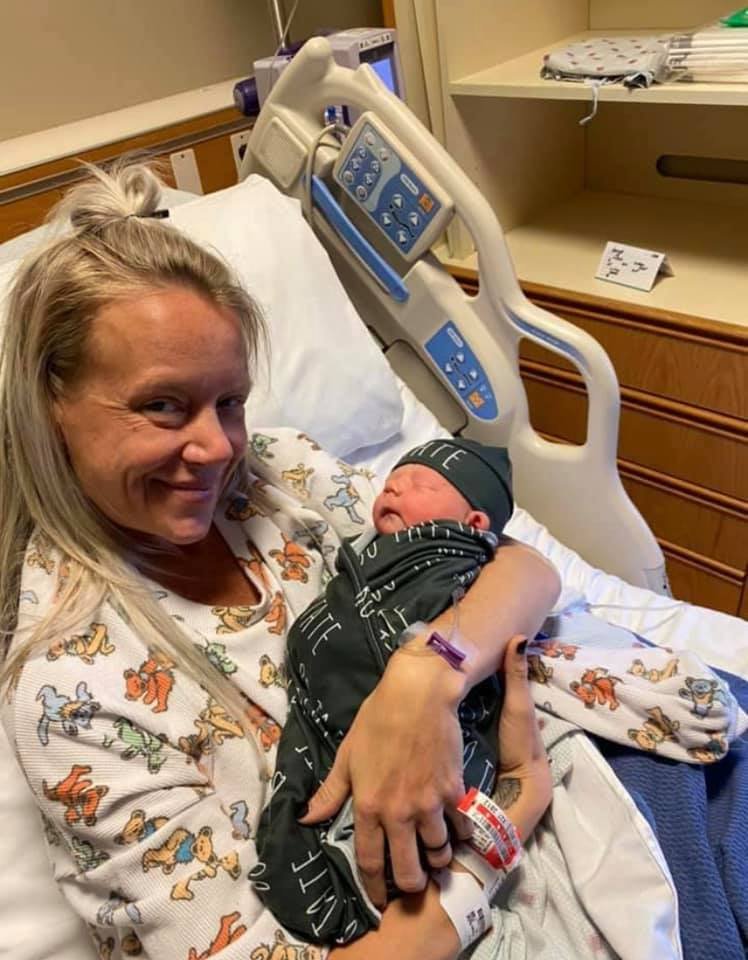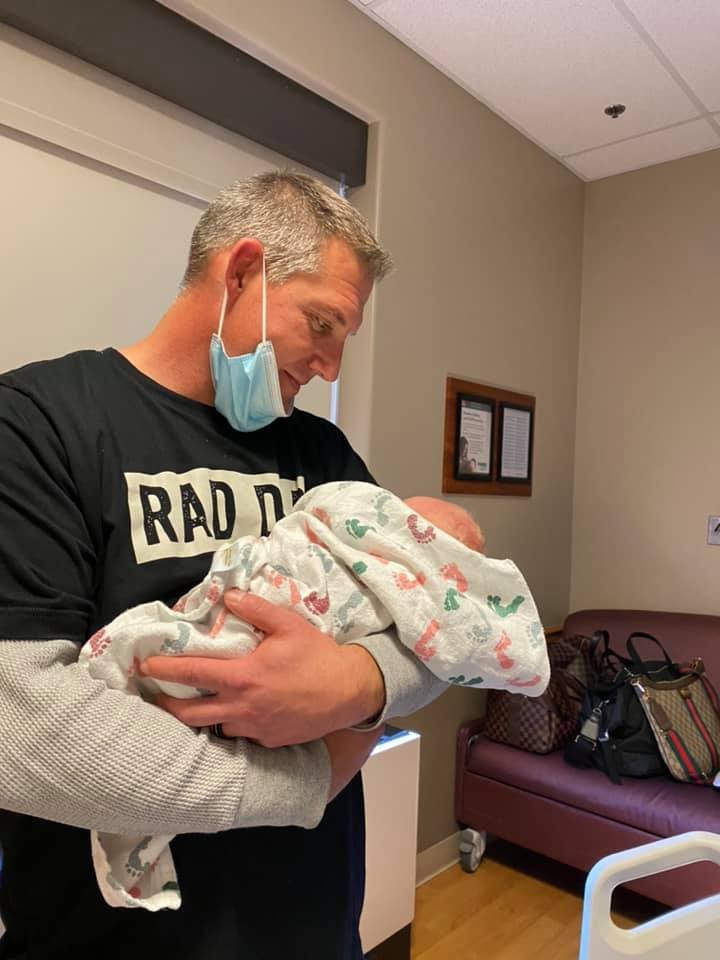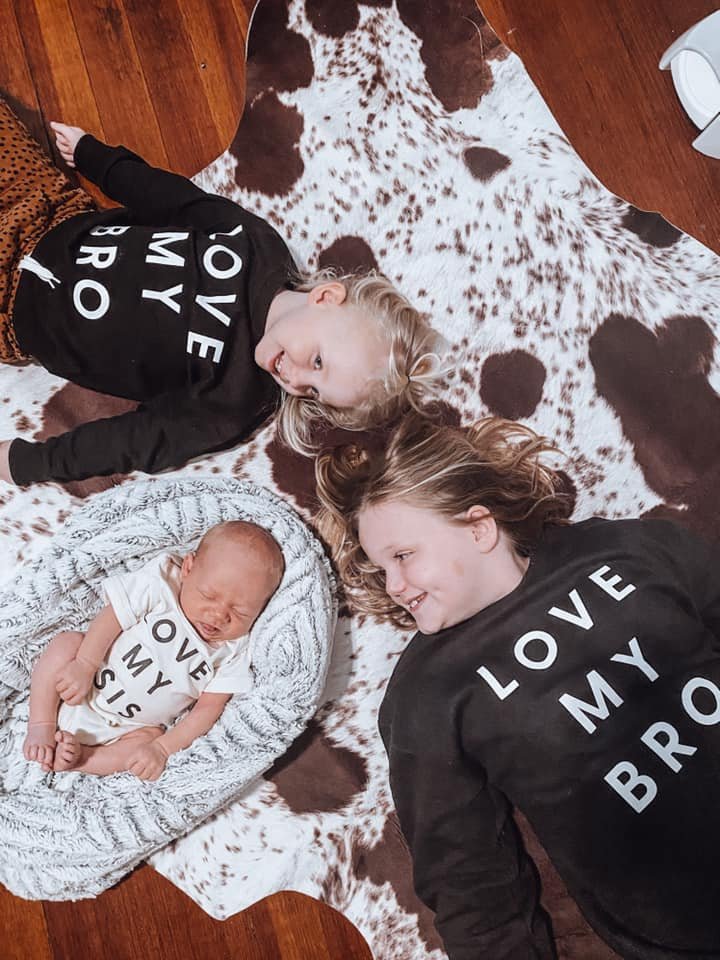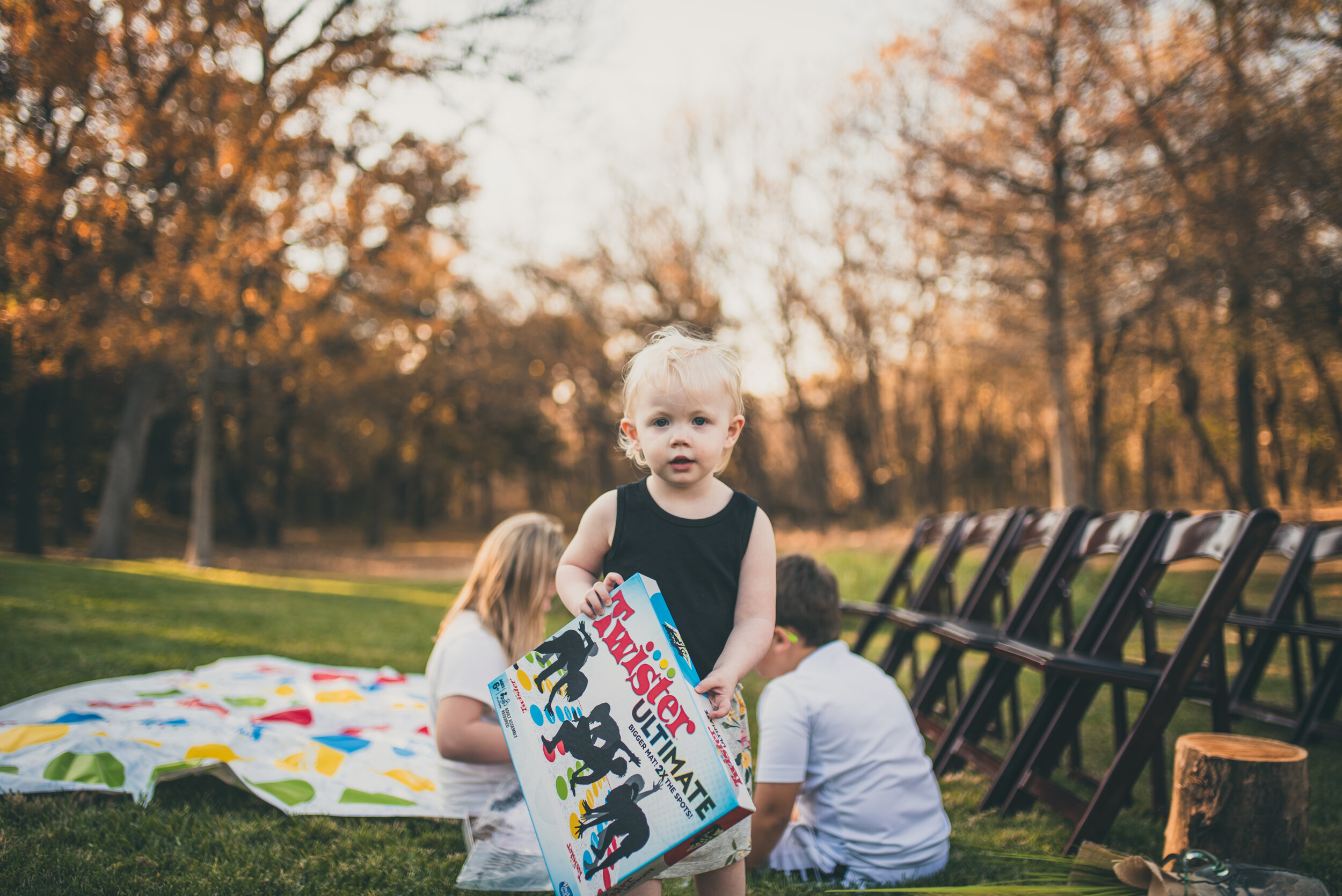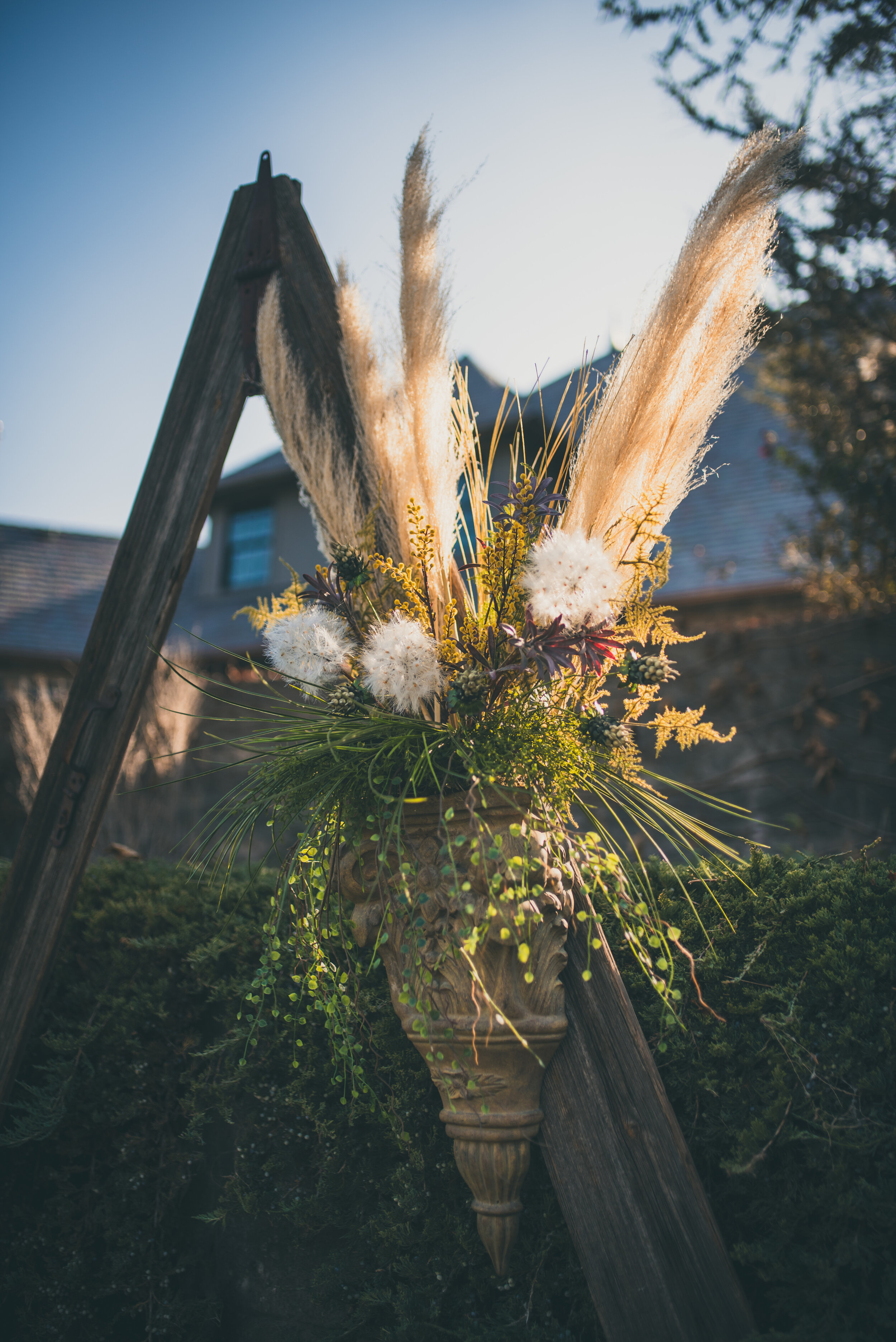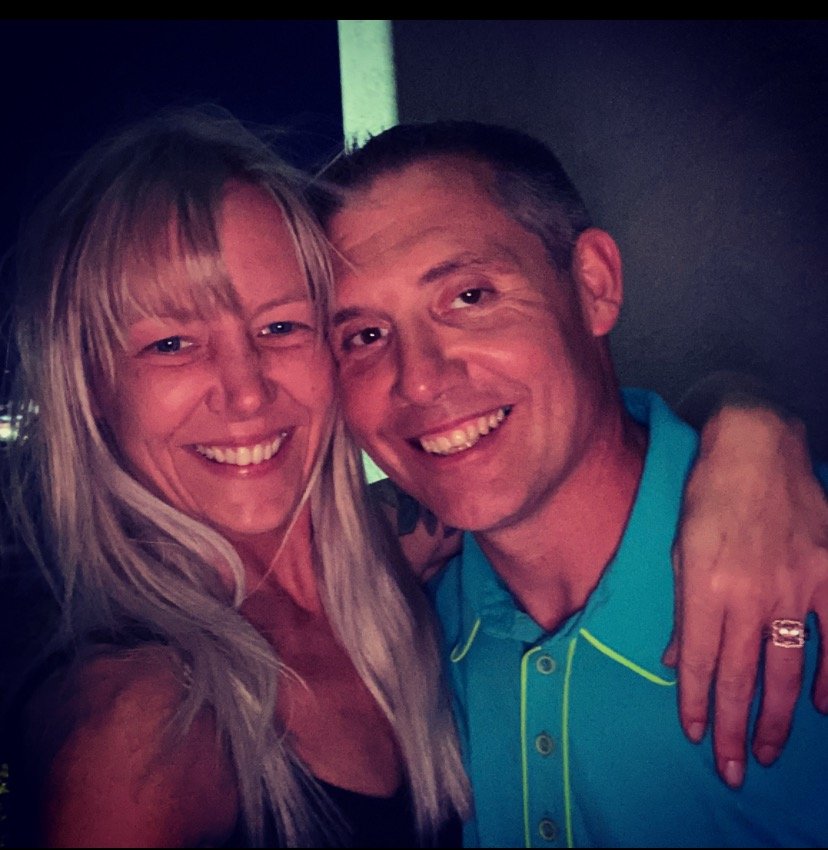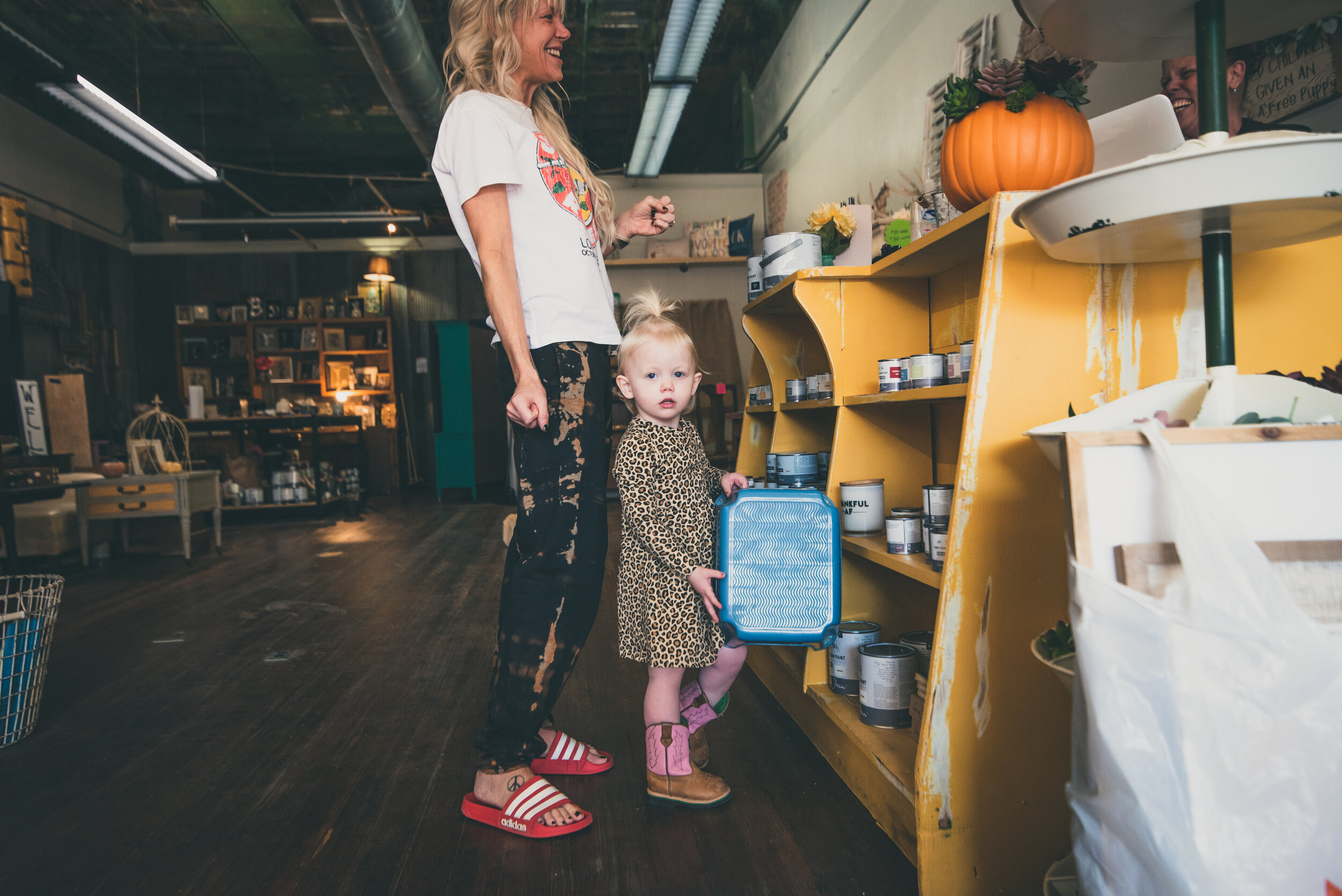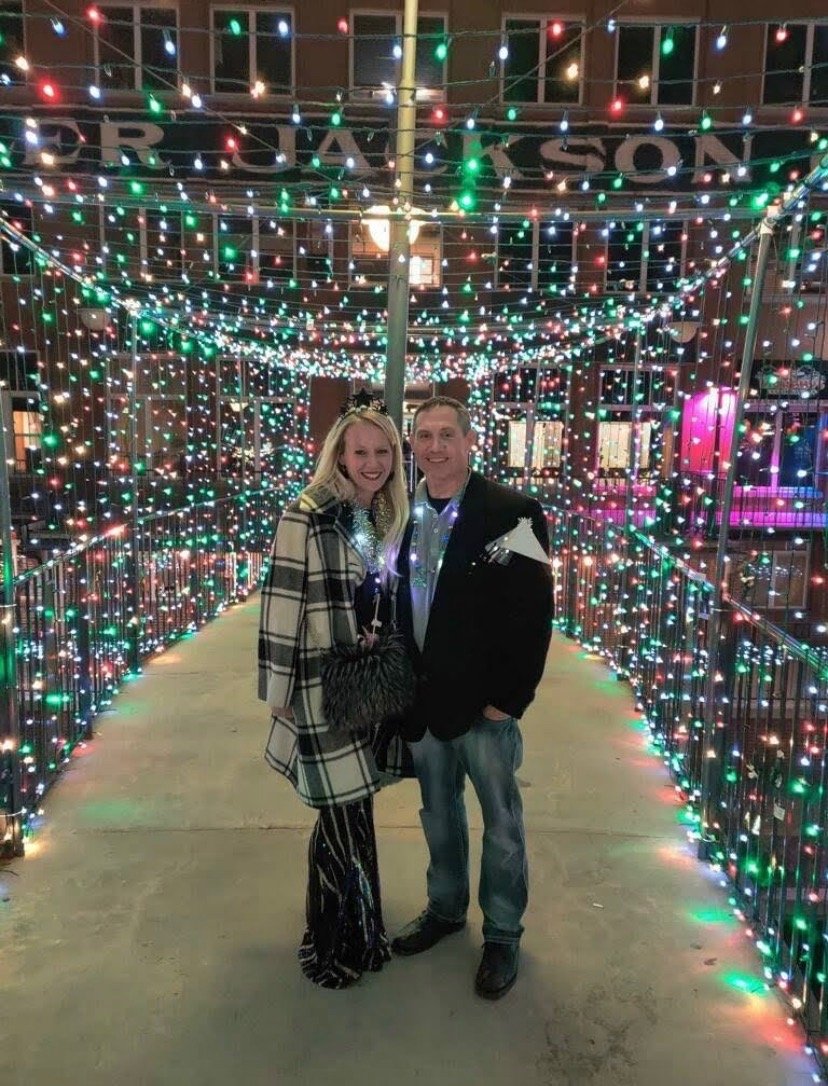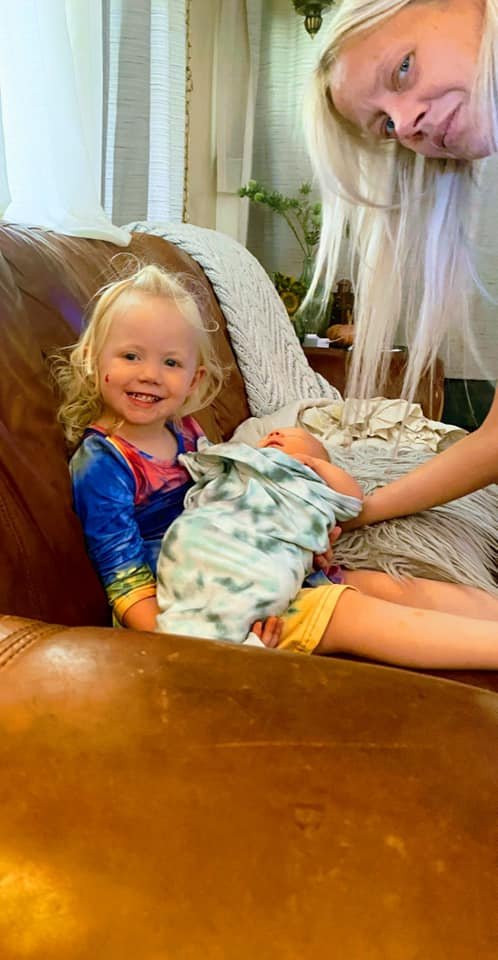After battling alcoholism and addiction for 20 years, Ty and Lindsey reflect upon the wedding day they never believed could happen.
Ty + Lindsey // Enid, Oklahoma
Content advisory: alcoholism, drug addiction, attempted suicide
This story is first a journey through regret, despair, and relapse; a future that only exists as a means of escaping the present; a display of how life not only could be worse, it has been worse. But through that journey is a story of faith, recovery, and promise; an example of finding joy after decades without; and a message that no matter how much pain you’ve gone through or how many bridges you’ve burned, it’s never too late to commit to a new life.
“Most days, things are just surreal,” Lindsey told me one evening at her and Ty’s home. “Ty and I used to joke about it… drunk, laying in a hotel room somewhere… how, oh, maybe, one day, we’d end up together. And our kind of love now is the love I never believed in. The stuff you see on TV, where you're like, 'That's not real. There’s no way.'” Lindsey looked at Ty, who sat beside her, and her two daughters, Lucy and Maggie, who played nearby. “But the way I feel about him… the fun we have with my girls. It's just like, this is so good, it can't be real, you know?”
Ty smiled, and added, with no small hint of disbelief, “I thought about her a whole lot when I was in treatment, because it helped me keep going with some sort of positivity. I would fantasize about this very day. Our wedding day. Someday. And it wouldn't even be as good as it really is in real life.”
Maggie, Ty, Lindsey, and Lucy at the wedding
When Ty and Lindsey first reached out to me, they said, upfront, that they’d already booked a photographer for their wedding, and that the reason they wanted to invite me to their wedding wasn’t because they needed more pictures. Instead, they wrote, “Our story is a one of a kind love story about two people who overcame addiction and alcoholism to be in a place they dreamed about. We’d love for someone to find hope in this story.”
Ty, the more outgoing of the two, had suggested participating, while Lindsey, more reserved, at first hesitated. But, after a few days of thought, she changed her mind. "Let’s do it,” she said to Ty, “because if one person can read this someday and get any sort of hope out of it, then it’s worth it.”
Lindsey and Ty on their wedding day
Ty and Lindsey were married on November 7th, 2020 in Enid, Oklahoma, in a friend’s backyard and witnessed by 30 people; mostly friends, some family. Their guest list would have been about the same size even without the pandemic. “This is the group, and it's probably even a little bit bigger than we anticipated,” Ty told me a few days before the wedding, saying how they hadn't been sure who would attend given COVID and a recent death in Lindsey's family.
Lindsey, who works in interior design, spent her morning decorating the surrounding forest with her two daughters, Lucy and Maggie, the former helping to unroll bundles of string lights and hang them in the trees, the latter a bit too young to help with anything physical, putting her energy instead towards brightening the mood and happily running around on the dry, windy, early-winter day.
Lucy helping Lindsey set up lights in the surrounding trees
Maggie playing the morning of the wedding
Some friends helped construct the wedding arch and set out chairs, and in early afternoon Lindsey and her daughters moved into the home's master bathroom so Lindsey’s bridesmaid Katy could do their hair and makeup. Many of the friends in Ty and Lindsey's wedding party were people they'd met in a sober-living home, including Leo, their officiant, and Austin and April, their best man and maid of honor and themselves a couple.
Ty and Lindsey’s wedding arch, built by friends
Lindsey’s bridesmaid, Katy, doing Lucy’s hair
At 4pm, an easy-moving piano melody began to play, signaling the ceremony’s start. Ty walked over to the arch with his groomsmen and watched as Lindsey’s bridesmaids walked down the aisle one-by-one, followed by Lindsey’s daughters, who wore matching white dresses and flower crowns.
A breeze cooled an already chilly fall evening as the music switched to a recording of Wagner's classic Bridal Chorus. Lindsey carefully walked down a nearby hill towards the aisle, her hand wrapped around the arm of her former boss, John, whom Lindsey credits with playing a major role in her recovery.
When they reached the arch, Ty gave John a firm handshake before he and Lindsey held each others’ hands and faced one another, smiling.
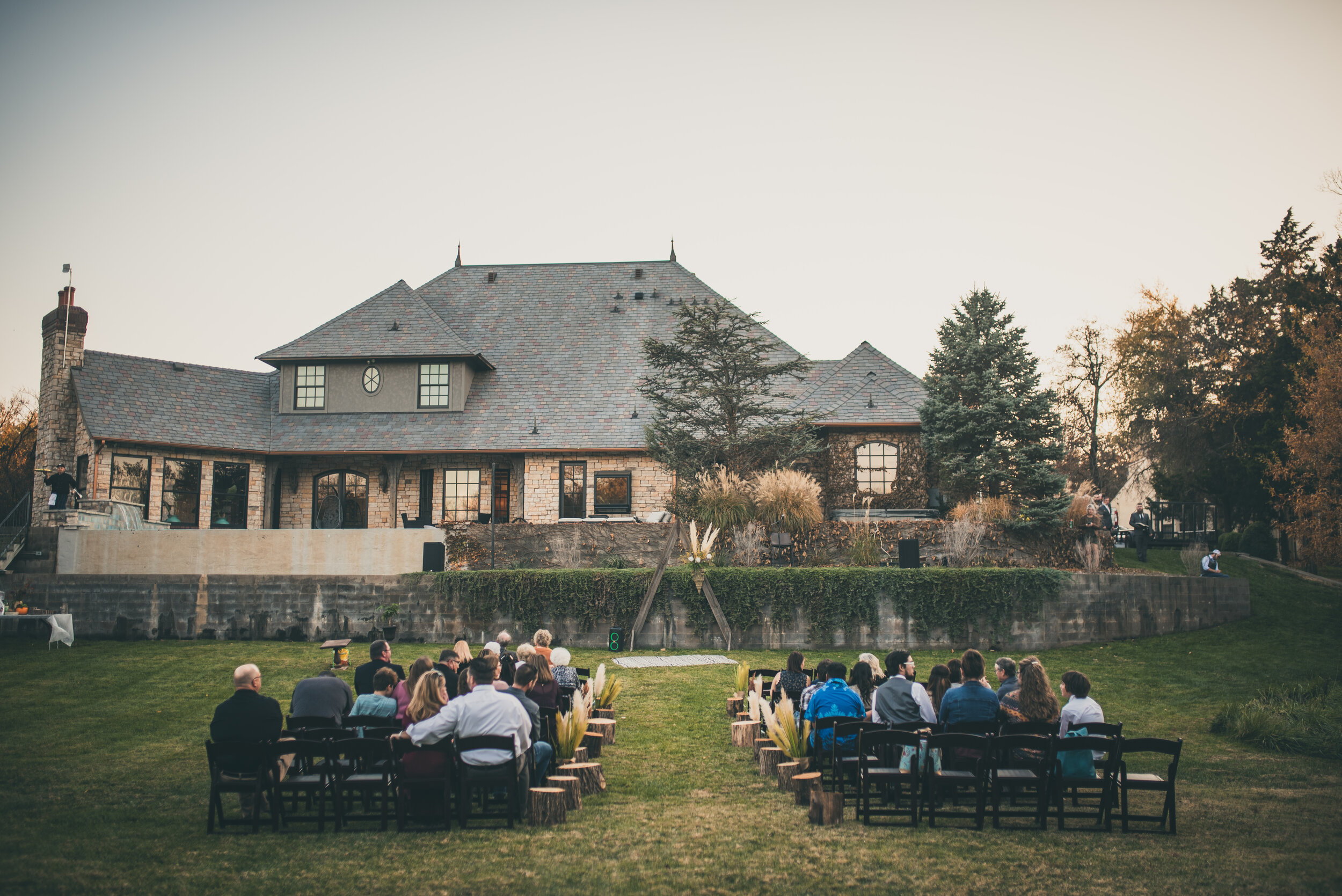
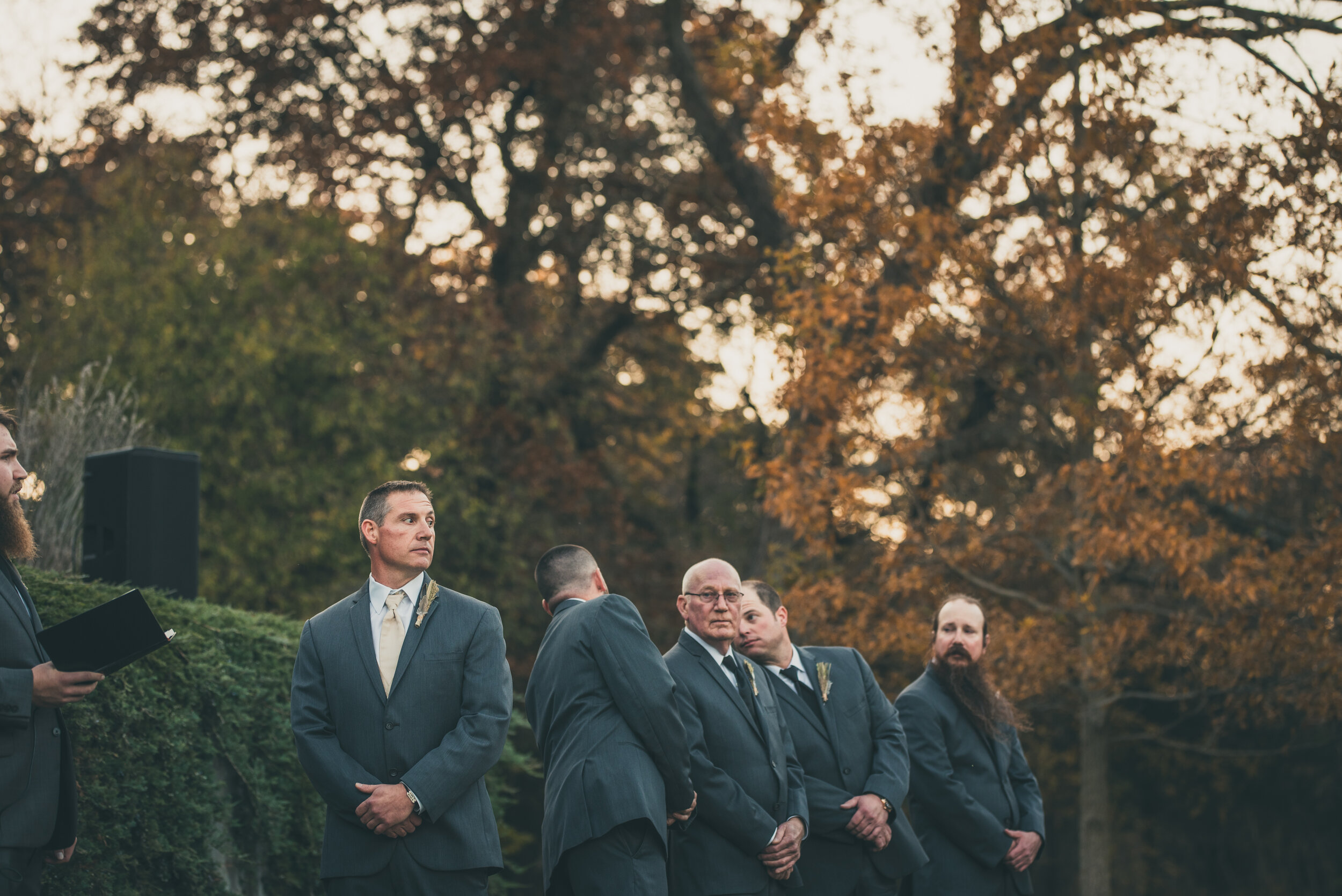
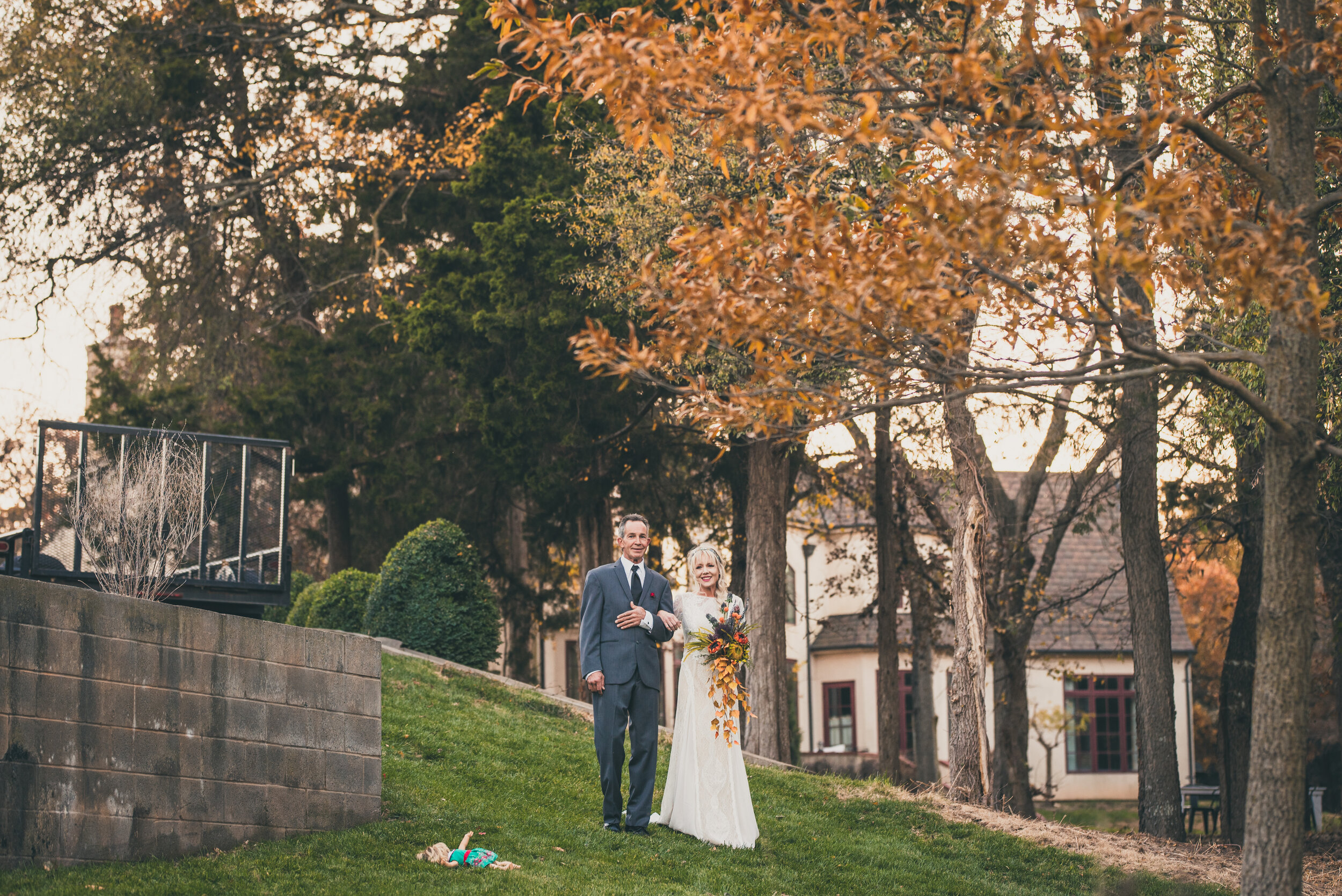

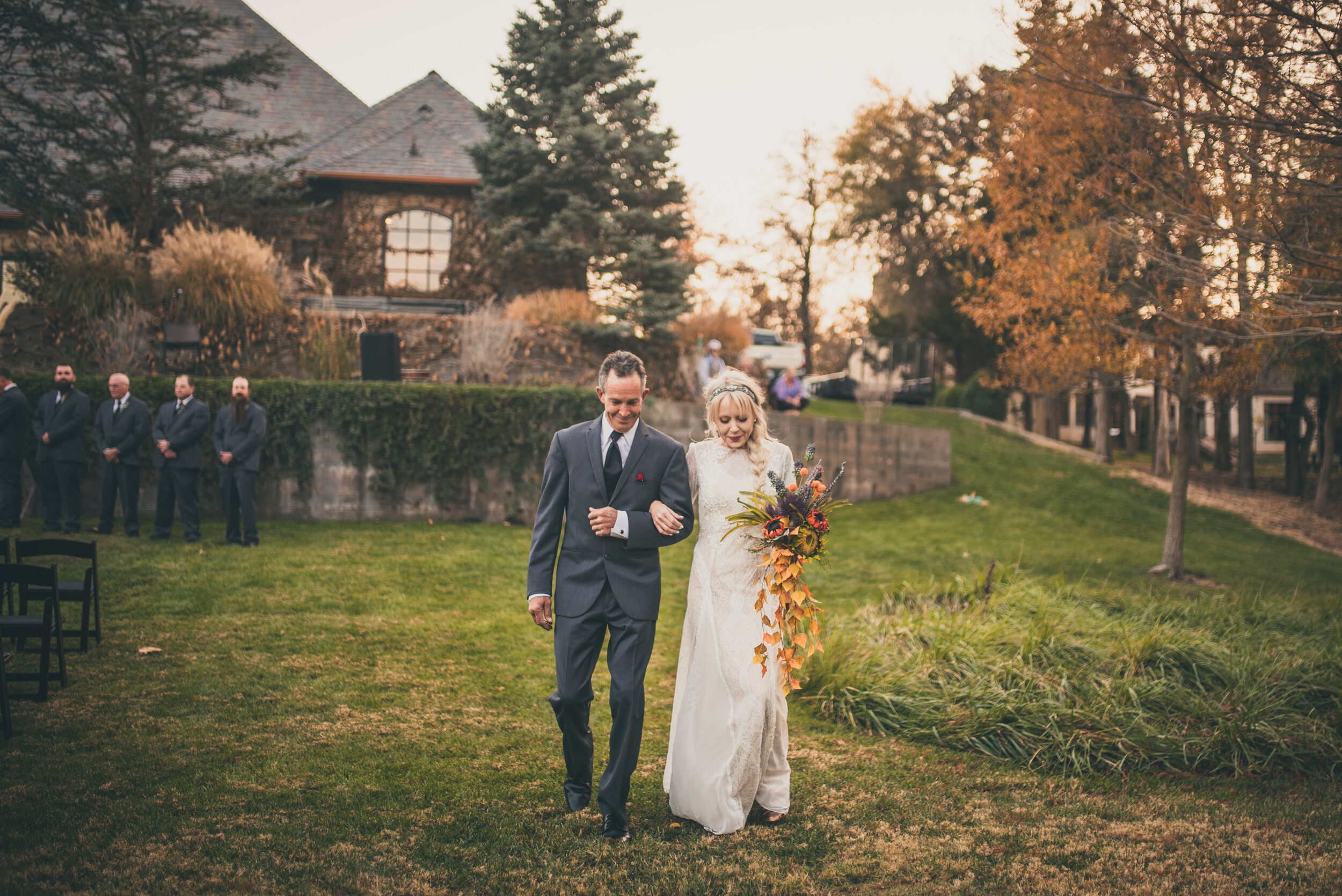
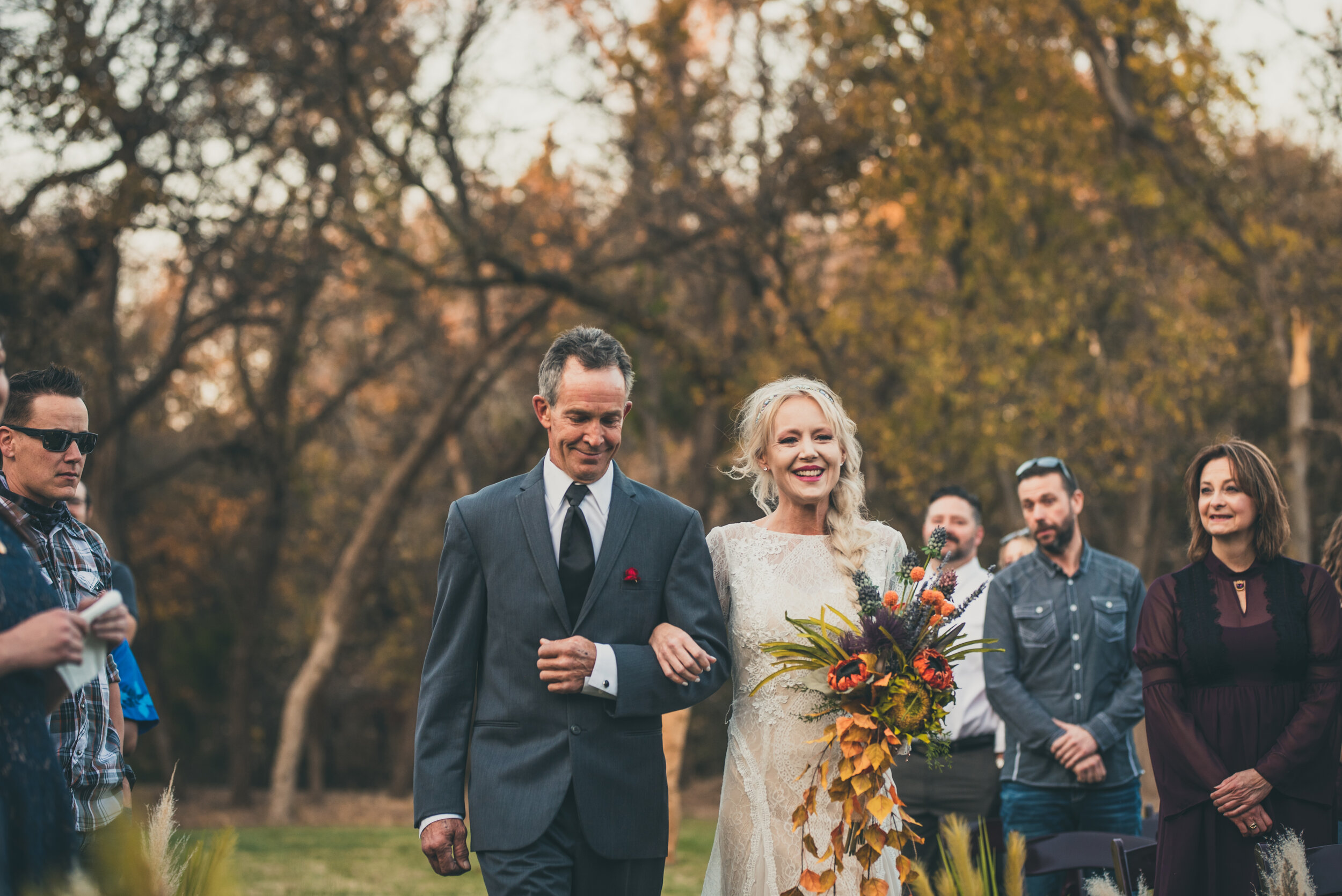
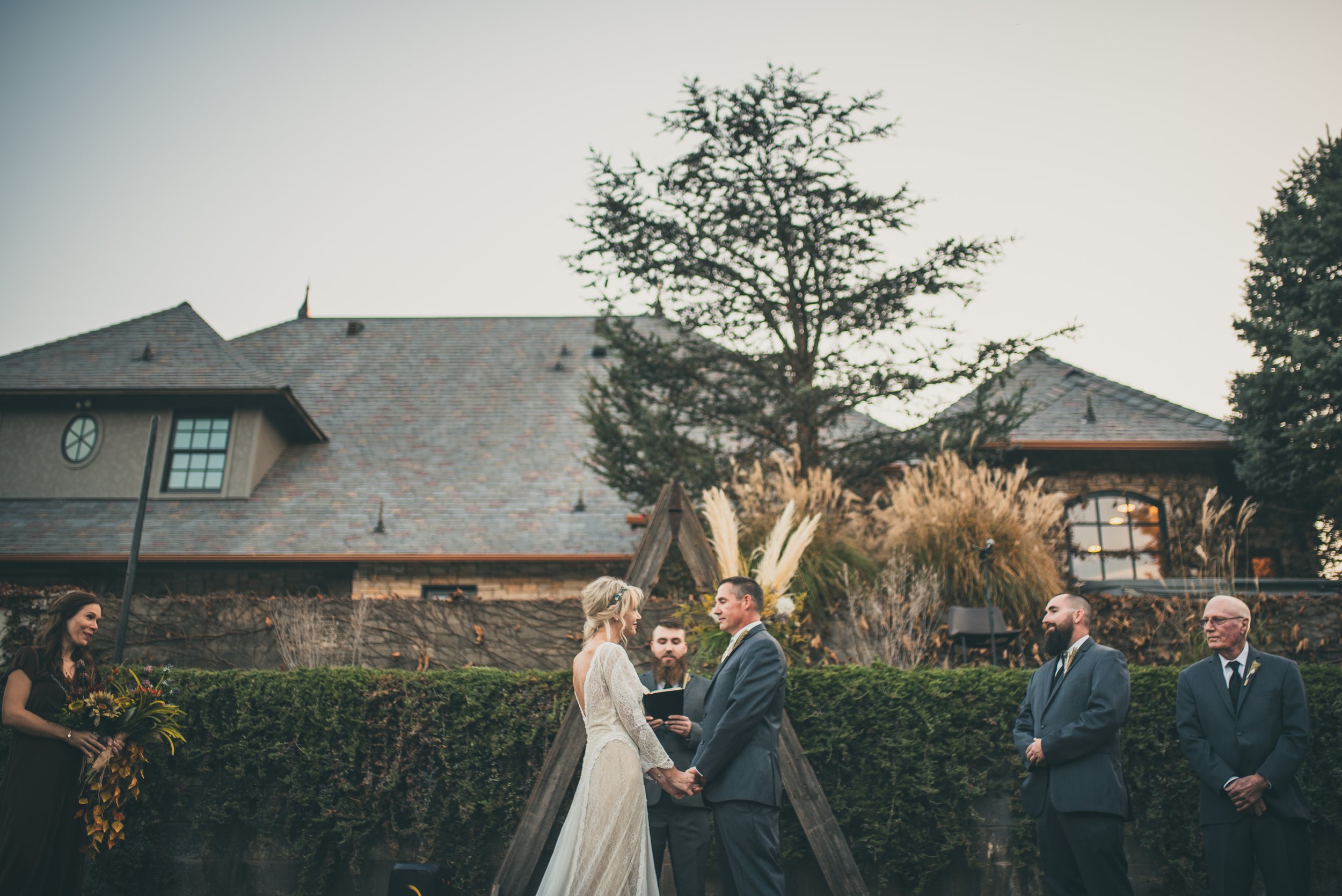
Photos from the start of Ty and Lindsey’s ceremony
Under the soft, yellow glow of an early November sunset, Leo began the wedding with a confident but nervous voice. (This was his first time officiating a wedding.) "Friends and family, welcome, and thank you for being here on this very important day. We're gathered here together to celebrate the very special love between Lindsey and Ty by joining them in marriage." He directed his next words towards Lindsey and Ty. "Your marriage today is the highest form of love between two people; the public and legal joining of your souls that have already been reunited with one another. Marriage is going to expand you as individuals, define you as a couple and deepen your love for one another. To be successful, you'll need strength, courage, patience, and a really good sense of humor. So let your marriage be a time of waking each morning and falling in love with each other all over again."
Lindsey and Ty laughing during their ceremony
Leo asked Ty and Lindsey to exchange rings and then, with Maggie and Lucy, plant a small tree to signify the joining of their four lives and their commitment to grow together in their relationship.
Lindsey, Ty, Lucy, and Maggie planting a small tree together
The rest of the ceremony flowed by quickly. Ty and Lindsey walked back to the arch; Leo pronounced them husband and wife; and they shared a long, well-deserved kiss. But right before they recessed down the aisle, the speakers that had been playing music throughout the ceremony suddenly stopped working.
Lindsey and Ty sharing a kiss at the end of their ceremony
Lindsey and Ty waiting for their recessional music
Ty and Lindsey, holding one another’s hands and eager to walk towards their guests, waited as a friend did her best to fix the speakers and play Mendelssohn's Wedding March. But after an awkward minute of silence, another friend began to belt out the tune herself. Laughter rose from the rest of the guests as they, too, joined a cappella.
Ty and Lindsey smirked, shrugged, and walked up the aisle hand-in-hand for the first time as husband and wife. The delay hadn’t bothered them; after waiting over a decade for this moment, a few extra minutes weren't such a big deal.
Ty and Lindsey recessing up the aisle
If there’s anything Ty and Lindsey wish other people knew about alcoholism and drug addiction, it’s that quitting was never as simple as knowing other people were right. “I remember my dad would tell me to just stop,” Ty said. “‘Just stop! ’ But if it were that simple of a choice, then most of us would have stopped a long time ago.”
He admitted that it may have been his choice to first cross the line; the first sip of alcohol, or snort of cocaine. He wondered aloud what would’ve stopped those initial steps. But after that, he said, no matter how much anyone else wanted him to stop or wanted to help, it made no difference until Ty wanted it for himself, too. “I don't know about that first step, but I do know that I continued to drink after that because I liked the effect," he said. "The thing is, I wasn't ready to get sober until I was ready, and I wouldn’t have listened to anyone anyway, because after it got bad, I just wasn’t listening to anything or anybody."
He remembers, at times, genuinely wanting to quit. “When we, as addicts, say we're done, we don't mean it every time, but we do a lot of times, especially later in addiction. But the smallest of things could go wrong, and we'd be right back. So many times, I'd just lay there and be like, ‘I'm done with this. I’m not doing this anymore.’ And then I would drink or do drugs again the very next day.”
Ty continued. “People looking from the outside see the destruction in our lives that addiction causes, and they’re like, ‘Why do you keep doing it? Why do you keep saying the same things to yourselves?’ And it's because we reach a point where we have no choice. There’s a quote in the book that says, ‘You've lost the power of choice.’ You can argue that point, but if you look at our lives, that's what happened. We lost the choice.”
The book Ty referenced, and which serves as his and Lindsey’s anchor in recovery, was Alcoholics Anonymous: The Story of How More Than One Hundred Men Have Recovered from Alcoholism, and the argument he referred to was that of the robust debate surrounding the efficacy of the 12-step method promoted therein.
Known as “The Big Book” in recovery circles, "Alcoholics Anonymous" was first published in 1939 and written collaboratively by William G. Wilson and the other men of his then inaugural class of recovering alcoholics. The language of its famous “12 step method" originally reflected its author’s devout Christian faith, but over time the steps have been adapted to allow a more "spiritual" rather than “religious” tone. The steps are:
Step 1: Admit Powerlessness
Step 2: Find a Power Greater than Yourself
Step 3: Depend on Your Higher Power
Step 4: Make a Moral Inventory
Step 5: Be Honest about Your Mistakes
Step 6: Become Ready to Remove Your Flaws
Step 7: Ask a Higher Power to Remove Your Faults
Step 8: Make a List of People You’ve Hurt
Step 9: Apologize to People You’ve Harmed
Step 10: Monitor Yourself and Admit Mistakes
Step 11: Commit to a Spiritual Practice
Step 12: Help Others
In brief terms, Ty described it to me as, “Trust God, Clean House, and Help Others.” The steps contain a mixture of self-accountability, widely accepted as being core to recovery, and release from blame in the form of yielding to a higher power, which some critics argue absolves alcoholics from taking responsibility for their own actions.
Regardless of the large-scale efficacy of AA’s 12-step method, the effect it had on Ty and Lindsey’s lives was transformational, though only after many years. “The program is set up where if you don't truly believe in it as the top priority, you’ll go back to your old ways," Ty told me. "And unfortunately, through my life, I’d be sober, following the steps, but then other priorities would come in my life, and I’d put recovery on the back burner. I’d stop going to meetings or praying, and sure enough, I’d pick it up again." He noted how clear the difference was in his life when he did and didn't follow the steps. "It was so obvious in my life that if I did what the program asked me to do, my life was good. But if I didn't do it, my life was real bad, real quick.”
Ty chafed at the idea that true alcoholics could ever return to casual drinking. “You may drink a whole lot, but that alone doesn’t make you an alcoholic. Because in my opinion, if you're truly an alcoholic, you’ll always be one.” I registered a slight frustration in his voice as he talked. “If you claim to be an alcoholic and say afterwards you can drink normally again, that's fine, as long as you don’t encourage other alcoholics to try that, too. Because it takes a lot of pain to get to the point where you inwardly accept that you just can’t have it, ever.” He spoke, I could tell, from personal experience and pain.
Ty and Lindsey first met one another in 2009 in a sober-living home called Van's House, when both of them were, at least outwardly, trying to get sober. Life in Van's House followed a relatively strict schedule and set of rules, though Ty and Lindsey emphasized to me that it wasn’t the same as a formal treatment center. The goal of living was to actually learn how to live life—pay rent, go to work, make friends—all while sober. (Sober-living houses are somewhat similar to halfway houses in that they provide a space for people to transition back into society, from prison in the case of halfway houses, and from addiction in the case of sober-living houses.)
Neither Ty nor Lindsey were, amid that first friendship in Van’s House, able to break their addictions, but they did form a lasting connection, and kept in touch throughout the early and mid-2010’s. The two supported one another when they would talk or hang out, though not always because they themselves were healthy. “He never got me too involved in what he was involved in, because he always tried to protect me,” Lindsey told me, referring to a period of time when Ty was actively dealing.
Lindsey and Ty together in 2020. The two do not have photos together from earlier in their friendship
Lindsey expressed some guilt, admitting Ty checked up on her more than she checked up on him. “It’s not often that we’ve both been on the wagon at the same time, so it was usually either him trying to help me or me trying to help him. If things were really bad for him, I wouldn’t hear from him. But even then, he was still the kind of person who would always pick up the phone for me if I called.”
I asked Ty what those moments were like on his end. “She was always on my mind,” he replied. “That’s why we would always end up talking again. The longest time we were apart was probably when I was in treatment, but even then I had people checking that she was okay.” He paused. “I wasn’t checking on anyone else when I was there.”
I debated for some time while writing this story about how much of Ty and Lindsey’s upbringings to include, and debated even more about how much to emphasize. The widespread belief about people addicted to drugs or alcohol is that their struggle can be traced, with certainty, to some tangible person or event: a particular moment of trauma, loss of a loved one, or depth of insecurity that single handedly explains how he or she stumbled upon addiction’s cruel path.
But that assumption oversimplifies not just addiction, but life itself. Our stories and personalities are rarely so simple as to be wholly defined by single choices or events, in the same way that a person can’t appreciate the full palette of colors in a painting by looking at a single brushstroke. To share a story of addiction then is to share a story of life; raw, complex, and complete.
Ty grew up in Texas, first in a small town of 2,500 people called Canadian near the state's border with western Oklahoma, and then in Houston when his dad worked on offshore oil rigs in the Gulf Coast. His parents divorced when he was six, after which Ty moved with his father to Arnett, Oklahoma to be closer to extended family.
Ty with his grandfather
In reflection, Ty can imagine the financial and emotional struggles his father faced while raising him and his brothers. But as a child, he never really noticed. “My dad was just a hard working guy who would go without to make sure his kids had what they needed,” Ty told me. His father did his best to be present in his sons’ lives, and always showed up to Ty's sporting events through middle and high school. “He’d be working, like, three jobs delivering pizzas at night, and still show up at my baseball games, sometimes in the middle of a delivery, just to watch,” Ty said. “Anything that I enjoyed, he went out of his way to make sure he enjoyed it, too.”
Ty’s father with Ty and his brother, Jeff
Ty’s life followed a stable, simple path until his Junior year of high school, when he tore three ligaments in his left knee. “Being in all these sports, I was pretty busy," he told me. "Go to school, go to practice, go home; I was pretty worn out. But when I got injured and couldn't play sports anymore, I started drifting towards a different crowd.” With his dad often working in cities and states far away from home, Ty threw parties and binge drank to the end of high school, a habit that only worsened when he got to college. “I did really poorly in my first semester of college. Like, a 0.69 GPA,” he said. “That’s when the addiction and alcoholism really caught up to me.”
The nearly two decades after that were, as he put it, “a lot of the same thing.” “I started with just drinking excessively, maybe occasionally smoking marijuana. The kind of dabbling you do as a youth. But when I got into college, I started doing other harder drugs more often.” Even then, Ty noticed that his behavior differed from that of his peers. “My friends would party on Friday and Saturday, recover on Sunday, and go back to school or work on Monday. But for me, it was non-stop.”
Ty soon dropped out of college on account of poor grades, a dearth of motivation, and the debilitating effects alcohol had on his mobility. “I couldn’t brush my teeth in the morning without having, like, a pint of vodka, because my hand would be shaking so much without it," he told me, and recalled that his first alcohol withdrawal seizure happened when he was just 24 years old. “I was sitting outside the liquor store at 9am, waiting for it to open at 10, but I didn’t like being the only one there. So I drove around the neighborhood, had a seizure, and drove through a house.”
As Ty’s addiction worsened, more and more of his friends and family distanced themselves from him, a dynamic that Ty’s friend and wedding officiant, Leo, told me was common among addicts. “Nobody wants to be around you when you’re like that," Leo told me, "because it's just sad to see one of your friends continue to do things that hurt themself.” Those who did continue to help Ty seemed to do so out of resigned sadness and pity, buying just enough alcohol for Ty so he’d avoid having seizures while keeping their emotional distance.
Through his 20’s, Ty was never able to hold down a job, and often resorted to sleeping on the streets. “For a point in time, I was homeless in Joplin and Springfield, Missouri," he said. "I slept outside of a liquor store, because someone else who was homeless told me that if I did that, someone might buy me liquor. I lived a lot of my life scrounging up change or doing whatever else I had to do to get my next bottle." He described the cyclical nature of his actions. "When I got involved with drugs, it became that I’d drink too much, then do drugs to offset the drinking, then drink more to offset that. It was like this pendulum of trying to get the right amount of everything just to feel normal. I wasn't even chasing a high anymore. It was just to feel normal."
As we talked, I began to understand what Ty meant when he’d said much of his life was “a lot of the same thing,” like a twisted version of a musical on tour, the locations changing week-to-week but the story remaining the same.
Act One: Promise. A genuine desire to get sober; reach out to anyone who might still be willing to help; perhaps even check into a recovery facility.
Act Two: Relapse. In Oklahoma; in Texas; on a cruise; in treatment.
Act Three: Escalation. Harder drugs; dealing; being both the passenger of a runaway train who believed the brakes no longer worked and the conductor who refused to pull the lever and find out.
If you were to see Ty during periods of Promise or Relapse, you’d be forgiven for thinking he was truly doing better. The problem, he told me, wasn’t something external that others could see. “My self worth was really low,” he said, “and I was presenting well but wasn’t working on the inside of me.” For a long time, he believed it was possible to be a “normal” drinker; to have a few beers at a friends’ party, maybe a glass of wine over dinner. Letting go of that thought, he said, was difficult. "It takes a lot of pain to get to the point where you're inwardly aware that you can't have it. Where you've tried pretty much every way possible to drink 'normally', and just can't."
Each time, the curtain would rise again on Act Three, Relapse, and each time Ty would go through the same destructive motions as before; he’d performed this role many times already, and his lines were now habitual.
Many of my conversations with Ty and Lindsey happened in their home, a two-story house in Enid, Oklahoma with high ceilings and an old, bucolic interior of original hardwood floors and frames. Piles of flowers were strewn throughout their dining room, evidence of Lindsey’s DIY spirit ahead of the wedding.
Lindsey and Ty’s dining room a few days before the wedding
Their wedding was the Saturday after the 2020 Presidential election, and in the days before we often talked as Fox News' election coverage murmured in the background, the TV volume turned down but the large electoral map of red and blue states visible out of the corners of our eyes.
In this setting, our conversations sometimes brushed against politics, but far more often turned to Lucy and Maggie, Lindsey’s eight and two year old daughters, both of whom played around the house as Lindsey, Ty, and I chatted in the living room. I asked Lindsey what both of their personalities were like. “Lucy's a people person,” she replied. “She makes friends wherever she’s at. Right now, she plays with these four boys in the neighborhood, and she's perfectly fine with that. We'll barely get out of the car, and she's like, 'Can I go play now?'”
She noted with pride how well Lucy was doing in school. “I’m really proud of her for having straight A’s in school right now, just because things have been so different this year with the pandemic.” Lucy suddenly zoomed by on a hoverboard, her cell phone in-hand, looking like she was in deep thought as she replied to one of her friends' texts.
Lucy on her hoverboard in the living room; Maggie is to the left and Ty is watching to the right
Lindsey turned to Maggie. "Maggie is totally different, and really loves being with me. She doesn't let me get too far away for long.” As if on cue, the little two year-old bumped into us with her own version of Lucy's hoverboard, a small bumper car that she controlled with a joystick as she whirred around the home. Ty added with a smile, "her personality is always changing now. Sometimes she comes back from her dad’s with, like, a new trick, and it’s so cute.” Maggie recently learned to hop to express her excitement or happiness, which Ty pointed out to me with noticeable joy many times in our days together.
Maggie playing on a toy set of drums at home
I asked how life changed when Lucy and Maggie, who alternate between living with Lindsey and Ty and living with their father, weren't around. “Sometimes I tell Lindsey, 'I’m ready for the kids to come back,' because they put everything in perspective real quick,” Ty replied. We often paused our conversations so that he and Lindsey could give their attention to the two kids, picking them up for kisses or playing with them; right now, Lindsey was a few dozen feet away in the kitchen helping Lucy grab a snack from the pantry. "One of the greatest things I love about her is the mom that she is," Ty told me as he watched Lindsey taking care of her daughters at home. "That's one of the biggest reasons I'm attracted to her."
Ty and Lindsey holding Maggie one day when Ty got back from work
If the outline of Lindsey's upbringing mirrors that of Ty's, the details are nevertheless very different. Lindsey grew up in Bixby, Oklahoma, a small suburb of Tulsa, and like Ty, her parents separated when she was six years old. She mostly lived with her mother growing up, and their church often helped the family with groceries and clothes.
A young Lindsey
Lindsey was a shy and quiet girl, preferring to play by herself than with other kids, and she kept that shyness through high school when she moved to Enid, Oklahoma, a much larger city of around 50,000, compared to Bixby’s 10,000. "The high school in Enid was way larger," she told me. "It was extremely intimidating, and so I just kind of kept to myself."
For her first two years of college, Lindsey continued to fly under the social radar and stay out of any kind of trouble. She started as a psychology major in order to go into social work before, in her Junior year, a series of large changes all happened within the span of two weeks: she transferred colleges, switched her major to interior design, joined a sorority, and turned 21. "We started going out, drinking and things like that, and it was a total change to my lifestyle," she told me. "That was probably the first time I'd ever gotten drunk."
Lindsey (right) at a college event
Her lifestyle progressively escalated over the following months. “Someone introduced me to weed, and I didn't really care for it. But then summer came, when some of these people I was hanging out with graduated, and that's when I found out they also did a lot of coke." Lindsey’s friends convinced her to try it, and she fell in love. "I was no longer the shy, awkward girl," she said. "It just made me more comfortable, especially in group settings, and helped me to not have as much anxiety."
Lindsey (left) at a college event
Cocaine led to other hard drugs, which soon formed her into a different person. “When I drink, it's kind of a Jekyll and Hyde thing," she said. "I’m either gonna be fun and the life of the party, or I'm gonna be crying and hateful, and you're gonna have to babysit me.” Lindsey began dating someone who had plenty of money to fuel her newfound drug addiction, and the next year she dropped out of school and quit her sorority before either could kick her out themselves.
As Lindsey continued to share, I noticed that she told her story as one long arc, moving chronologically through her life and directing the spotlight of her memory towards a wide and varied set of topics: exes, addiction, thoughts of suicide, her family, dreams, fears. As she spoke, I thought again of the analogy of a play on tour, its location changing but the story remaining the same, and pondered another part of that analogy: the actors in the play, and their prominence in the foreground or background.
When we think of someone's battle with addiction, we often imagine their struggle in the same way that a solitary performer unfolds a grand soliloquy beneath a bright and narrow spotlight, the other actors hidden in the stage’s dark and invisible wings. But a more accurate depiction of an addict’s life, or anyone else’s for that matter, is that of a play with many actors illuminated by a floodlight instead of a spotlight, each moving to the foreground to command attention for a short time before retreating to the background and yielding to another actor. Put this way, Lindsey's struggle with addiction played the role of a supporting actress, sometimes placed front and center in her life—when she was in a treatment center, for example—but more often stationed just off to the side, a constant presence as other concerns—family health, work, a relationship—took over the stage.
Lindsey was nearly always dealing with one cycle of addiction or another. She admitted that, as many times as she went into treatment or recovery, she wasn’t truly ready. "My mom would put me in treatment, and I just wasn’t ready to get help," she said. "I was medicating, because I was in so much pain and that was the only way I could sleep at night." She bounced in and out of jail and rehab for a few more years, and told me that, like Ty, she struggled with the concept of never being able to drink again. "I couldn't wrap my mind around it," she said, "and I was not willing to surrender to that."
Lindsey, having grown up within church, also struggled with God. "Just because of the whole, 'Why do bad things happen to good people?' kind of thing,” she explained. “Like, if God is so good and big, why does all this bad stuff have to happen? I was stuck in my addiction, just hating myself, and at the point where I couldn't stop. I was just in a weird place with God, and I could not fully give myself to Him or recovery. So I didn't really... didn't really have a standing chance."
The closest Lindsey got to being sober was right after a months-long stint at a treatment center. "I ended up getting a temp job and was, like, convinced I could drink like a normal person. And I kind of handled it for a little while." Lindsey reconnected with someone from high school ("He was actually my first, like, real date in life,") and because each lived with their families, hanging out meant going out. Bars, she said, were their most common choice.
"And then, of course, I got out of hand," Lindsey said in a voice tinted with equal parts plainness and shame. "If I get sober for a while, and then I relapse, sometimes I can keep it afloat for a bit before I set everything back on fire."
Lindsey became pregnant with Lucy soon after that, and the months of sobriety, like formal treatment, acted as a sort of chemical reset to break some of the harmful neurological loops in her brain. But after she had Lucy, and life returned to its normal, unyielding pace—troubles with finances, personal relationships, and a severe but undiagnosed postpartum depression—she again reached for the familiar numbing feeling of alcohol. "I started to drink one glass of wine in the evenings," she said, "but that wasn't enough for me, so I started hiding bottles in my closet so I could go back there and chug it and feel okay."
Lindsey when she was pregnant with Lucy
She was soon addicted again, and lost custody of Lucy. "I had a couple of suicide attempts because I didn't want to live without her," Lindsey told me. She checked into a sober-living home, this time with the motivation of seeing Lucy again, and after a few months managed to earn back visitation rights. But again, "I lost my job, some other stuff happened, boom, boom, boom, just in a row, and I ended up drinking one night."
Lindsey with a young Lucy
"I was too scared to tell anyone because I didn't want to lose Lucy again," Lindsey said. "But I ended up telling Ty, because I always told him everything. And he helped put me in treatment, again."
I sometimes hear from couples how they believe the strength in their relationship comes from having shown their uglier sides to one another and remaining in-love all the same. If that's true, it's harder to imagine an uglier side than what Ty and Lindsey have shown one another since first meeting, and a stronger bond formed as a result of that. "He already knows everything, which is nice," Lindsey told me. "I've never been able to be so open with anyone, because with everyone else, there's always something I've had to try and hide. I have to worry about, 'Oh, what if he finds this deep dark skeleton out about me?' But with Ty, there’s none of that, because he already knows everything, and he doesn't judge me for it." Ty added, "We always had each other's back, because you go through a lot in active addiction, and a lot of people in your life don't understand it. People look at you and treat you like you're less-than."
Ty and Lindsey on their wedding day
Ty and Lindsey's journeys towards true, sustained recoveries only began a few years ago when Lindsey had her last drink in 2016 and Ty had his last drink in 2018. Ty reflected upon the beginnings of his battle, and how, if there weren’t a single explanation for his addiction, he could at least try and describe an emotion. "I know that I never quite felt comfortable," he said. "I never quite fit in, or I just wasn’t okay with who I was. I think drugs were just a symptom of the bigger issue, because once I found out who I was, and was able to work on that bit by bit, life got so good, and there wasn’t a point to doing all those things anymore."
He told me about how, over his years of active addiction, his family tried to find resolution to the question of "what went wrong? " “Everyone was trying to figure out why I was an alcoholic," Ty said. "First, they thought it had to be because I didn’t have a relationship with my mom, so they sent me down to Texas to see her.” That, it turned out, was not the reason, nor did his time with her go particularly well.
His family kept searching, and failing, to find a “reason,” a two decades-long process that took a huge toll on them. “I know that my dad’s gone through a point in his life where he blamed himself,” Ty said, sharing how it was only in recent years that he'd been able to connect with his father. “My dad's been my rock my whole life, but we didn't have big emotional talks in the past. But now, that’s changed; we do have heart to heart conversations now." Ty’s voice soaked with emotions. "On my one-year anniversary of being sober this most recent time, my dad told me, 'This is the proudest I've ever been of you.'"
Ty (left) with his father (right) and groomsman Chance (middle)
I wondered what, ultimately, helped him to get sober. Was it willpower, I asked? "Not really," he replied. "It was more doing a lot of research and realizing how clear it was what I needed to do." He told me about the knowledge in his head; the years in treatment centers and all of the books he’d read; his theoretical comprehension of how to live a sober life; how that knowledge built a foundation for when he finally decided, for himself, to get sober. In 2013, he had a suicide attempt. “I was just more hopeless than suicidal,” he winced, “but what I held onto after that was the idea that I knew the program worked, but that I just was never in a good place for long enough for the changes to be lasting.”
Learning about and believing in the “disease concept” of alcoholism is ultimately what helped Ty. Formulated in the 1930's in a book by E. M. Jellinek, a psychiatrist and Director of the Center of Alcohol Studies at Yale Medical School, the framework offered a way for those who worked with addicts to present alcoholism as a chronic disease and thus remove its stigma and promote empathy by the rest of society. Jellinek argued that, like with other diseases, patients suffering from alcoholism passed through various phases:
Pre-alcoholic phase, which includes social drinking when drinkers often start to develop a tolerance for alcohol and drink to relieve stress or feel better
Prodromal phase, also considered the early-alcoholic stage where blackouts begin to occur, the drinker begins to drink alone and in secret, and thinks about alcohol frequently while their alcohol tolerance continues to grow
Crucial phase characterized by a spiral of out-of-control drinking at inappropriate times and problems with daily life and relationships as well as physical changes to the brain and body
Chronic phase which includes daily drinking, drinking as the main focus of life, health problems cropping up, cravings and withdrawal symptoms, and physical and mental long-term alcohol abuse issues
(It's important to mention that this framing of alcoholism as a disease, while rooted in the positive act of destigmatization, has its critics, who argue that categorizing alcoholism with the same vocabulary as cancer, malaria, and diabetes is at best inaccurate and at worst insidious. Cancer, critics argue, does not disappear just because of an intense desire to recover from it, but that is the fundamental requirement in 12-step to recover from alcoholism. Proponents counter by noting that the framework gives addicts a vocabulary and biological understanding of addiction’s real chemical effects on the brain, and thus something concrete to fight against.)
Ty remembers being in a hotel room one night when this knowledge, along with a series of low points in life, clicked. “God finally gave me just a moment of clarity," Ty told me, "and He said, ‘This is not gonna end well for everyone around you. For you. For your dad.' And that moment was enough for me to finally make a decision to do something about it.” He talked about the emotions that held him back before. “There's so much fear behind it. That's why people stay in active addiction for so long, because even if you're miserable, you at least know what's coming. Trying something new can be even scarier.”
From then on, Ty has followed a simple creed: build faith, and follow the program's steps. The former was somewhat of a new experience for Ty, who has identified as being a Christian his whole life but "never really had an actual relationship with God.” Much of his faith now stems from results he's seen. “I've gone through so much, but when I just trust God, and then I come out of an event fine, I remember that when something else crops up again, and how when I trusted God I was fine then, too. He’s been giving results, so my faith is growing.”
Lindsey, similarly, came to sobriety through a certain recognition of the terrible present. "I think that I just had to get to the point where I was tired of starting over," she said. "I've relapsed several times now, and I was always able to bounce back relatively quickly. But I just got to the point where I was tired of having to always rebuild everything." Her moment of clarity wasn’t as obvious as Ty’s, but it has led to the same trust in the program and in her increasing faith.
Amidst their most recent recoveries, Ty and Lindsey reconnected, and because each had arrived at their own commitment to get sober, they decided to give actually being together a chance. The two began dating in 2020, and described their relationship as God giving them the right chance at the right time. "If we would have tried to get together back when we were in the midst of alcoholism and addiction, there would have been a lot of things that could have happened that we probably wouldn’t have overcome,” Ty told me. “Our relationship taking this long to happen; I think that was a God thing. It was Him waiting for us to get our lives together before giving us a real chance to be together."
Lindsey and Ty together when they were dating
Their lives while sober have been anchored by the unconditional love of a few core friends, two of whom, April (Lindsey's Maid of Honor) and Leo (their officiant) I talked to. "Lindsey, Ty, all the others are my second family," April told me. "It wasn't until I met them and others in recovery that I understood what real friendship was, what actual support meant." She'd known Lindsey for about six years now, and each had seen, and cried over, the other relapsing. "When I relapsed, I was her roommate, and so it hurt her a lot and broke her heart…"
April paused to wipe away tears. "Sorry... and I still remember that lock on her face when I came back, and she was still in the house, and how it hurt her and broke her heart." April, likewise, remembered seeing Lindsey suffering through her own relapse. "I kept telling other people, 'Lindsey needs our help!' And they just told me, 'April, you have to let her figure this out on her own.' And it was hard... It was really, really hard. Because I needed to be there for her if she needed anything, but I couldn't want this for her."
Lindsey and April in 2018
"I am terrible at figuring out the right words to say," April continued, smiling through watery eyes, "but there is a gratitude that we have to those who know what we missed out on, and all that we have to look forward to that we're not willing to take for granted anymore. It's being grateful every day for what we have."
Leo expressed a similar gratitude. "I was 18 or so when I first got to Van's house," he said, "and I was scared, man. Because I went through all this addiction when I was a teenager, but I never learned how to just be a man. I never moved into an apartment, paid rent, paid a phone bill. And that's where Ty came in and helped me a lot." He laughed. "My relationship with Ty would be weird to most people. Like, a 22 year old being friends with a 40 year old? But he's become family, like Lindsey and the others, too."
Ty and Leo in 2019
Leo continued. "I remember talking to Ty about how he was already starting to feel good after a few weeks in Van's house and how he was happy. And I remember asking him to be my sponsor, because I had already been there for 16 months, and I still didn't feel that way."
Ty and Lindsey with their wedding party. April is second from the left, and Leo all the way to the right
Alongside their friendships, Ty and Lindsey have also found stability in their life through work, Ty as a supervisor at a nearby Tyson factory, and Lindsey as her own boss. Ty shared about how he didn’t hide his story, even in a professional setting. "I'm very open about who I am," he told me, "especially because if you just met me, you probably wouldn't have any idea of what I've been through. I've found that just being transparent helps a lot."
Lindsey, too, found motivation through an empathetic and kind boss, John (who walked her down the aisle,) calling him someone who "made sure that I did not roll over and give up, who made sure I kept moving, always willing to help and never expected anything in return other than for me to just show up for work and do what I'm asked."
Lindsey’s boss, John, walking her down the aisle
After working for John, Lindsey decided to open her own store, called Peonies, in downtown Enid, which sells various home-decor items like signs, trinkets, and specialty paints, as well as doing furniture restoration for customers who want old antique pieces to be repaired and repainted. It opened in July 2019, but with COVID, had been struggling.
Inside Lindsey’s store
I visited the store with Lindsey one afternoon. When we entered, her business partner greeted us; no one else was in the store. Maggie, Lindsey's youngest daughter, bounded around, unaware of her mother's emotions.
Maggie and Lindsey in her store
Lindsey looked around, her face expressing a soft combination of longing, disappointment, and frustration. "We've had good weeks," she said, "and then we've had really bad weeks. And now the bad are just outweighing the good."
Lindsey showing a picture of what the space used to look like
She was visibly dejected, and yet I thought of my conversation with April from earlier that week, when she'd told me, "In the past, the store could have been something that she easily drank over. But she's kept her head up, and even without me having to say it, she was able to say how it was sad how hard she'd worked for this not to work out, but that there were a lot of positives too; the chance to downsize, and not be tied to the store five or six days a week, for example." April logged a sense of joyful pride for her friend.
Lindsey with Maggie in front of her store
Unlike in the past, where Lindsey may have turned again to alcohol, now she had a home and loving family to come back to each night, no matter how hard each day. "I certainly appreciate my time with my two year old differently," she said over the noise of Maggie banging on a set of baby drums at home. "Because when Lucy was that age, I missed a lot."
Maggie and Lucy by Lindsey and Ty at the wedding
One evening, as we watched the kids play, Lindsey told me about how she'd given a lot of thought towards the way she wanted to raise them. "I think Lucy's starting to understand what it means when she sees us helping people," Lindsey said, “She sees that I'm happy. And I feel better because I'm setting a better example for her. I'm not in a miserable place.”
“I just want her to know that if, God forbid, she struggles with alcoholism and addiction one day, there's help. That she doesn't have to be hopeless. That she can be transparent with us."
Lindsey with Lucy
As filled with meaning as their presents are, Ty and Lindsey still feel glimpses of their pasts in daily life. “We’ll drive around Oklahoma City sometimes and he’ll think of something from his past,” Lindsey said, looking towards Ty. “Other times, we’ll go eat at a restaurant with some friends and someone will ask if I’ve ever been there before. And I’ll say I have. And they’ll ask how the food is. And I’m just like, I haven’t eaten there before. I’ve drank there before, but I have no idea if the food is any good.” Friends or acquaintances relapsing also fill them with sadness and reflection. “When I see someone struggling, I’m like, ‘Oh, this is what my family felt like’. Not being able to save me or change anything, and just having to watch me go through it. It feels terrible.”
Recovery, they said, is and would always be an ongoing process. “We want to always keep learning and to keep an open mind,” Lindsey said. “Because you can get to a point where you think, ‘Oh, I’ve got this figured out,’ where you start to think you’re good. And that’s often when you’re the closest to relapse.”
Ty and Lindsey together around Christmas 2019
“We have a saying,” Ty added, “No matter how far we are from the last drink, we’re just as close to the next one.” He told me about why that was; how impossible it was for them to remember the pain of their past as viscerally as when they actually experienced it. "There's a part in the book," Ty began, "that says 'We're unable to bring, with enough force in our consciousness, the suffering and humiliation of even a week ago.' A lot of non-alcoholics will ask, 'Can you not just see what that did for you in the moment? Why would you repeat it?' And yes, of course we can, but what we'll remember are the 10 minutes we were happy."
"There are moments where we forget where we're at, or where we've been; where we get caught up in the moment and forget how bad it used to be; where we think we just want the present pain to go away,” he continued. “But then the memories of the past come back, the pain from then, and we’re like, oh, yeah, maybe what I'm experiencing right now really isn't that bad."
Lindsey and Ty on their wedding day
Ty and Lindsey's pasts now serve as an asset for their presents, and as a fiery propellant for their desire to help others. Ty sponsors recovering alcoholics, both spend their Sundays feeding the homeless, and they each have other family members or friends struggling with addiction whom they can now relate to based on their own struggles. "There have been some issues going on with our families," Ty said, "and now we're the ones that they call. It's full circle, come back from being the addicts that no one in the family wanted to speak to, and now being in a place to speak to others because of what we went through."
Ty and Lindsey both envision a simple future. "I see us doing some of the things we already do now; sitting on the porch, talking, small weekend trips to Oklahoma City just to get away," Ty said. Both expressed wanting to make the most of the life they've been given, and earned, back. "I didn't get sober to sit on the sidelines," Ty said. "I got sober so I could live life, and that's what I want us to do. I'm not going to take this 32nd chance at life for granted." (The two especially love simple vacations where they stay in new hotels in Oklahoma or Texas, so much so that Ty proposed to Lindsey on the balcony of one on June 6th, 2020.)
Ty proposing to Lindsey on a hotel balcony
I visited them at their home again in November of 2021, soon after their one year anniversary. The hope they’d had the previous year of having a son had turned to a reality; Bo Tate was born on October 25th, 2021, and when I visited they let me hold him and take a picture together.
Me holding Lindsey and Ty’s son, Bo
We caught up about all that they’d experienced in the previous year; Lucy and Maggie each growing like weeds, the former becoming more mature each day as she crept closer to her teenage years, the latter learning to talk and using the word “Why?” as a substitute for any conversation; vacations they’d taken to California and Texas as a family; people they knew who’d relapsed, and one who died; their families’ health and friends’ support.
We talked again about the kinds of values they wanted Bo, Maggie, and Lucy to have. "I don't want our kids to ever feel like they can't call us,” Lindsey said. “I want to give them a sense that they can talk to us about anything; that it's okay to be human; that they know what unconditional love means."
Ty told me that he’d soon be done with his Bachelor’s degree in Psychology, which he’d been working on online for a few years, in January 2022. That’ll allow him to someday open up a sober living home, similar to the one that helped him and Lindsey over the years. He recognized how difficult of a business, both emotionally and financially, that could be. "It's true, the success rates are not very high," he began. "But I have an old mentor of mine who'd always tell me that we're in the effort business, not the results business. We put in the effort, and leave the results up to God."
What would make it worthwhile, he said, is knowing others would be able to experience the same, simple joys that he and Lindsey now experience every day. "Some of our friends just bought a house, others found out they're having a baby, and seeing all these exciting, good things happen at the same time; it's really fun to just see everyone so happy."
We all looked towards Bo, born on October 25th in an emergency C-section, only a few weeks old, cradled in Lindsey’s arms. He slept, quiet and content, oblivious to all the improbable miracles that led to his birth and to how much joy he brought in his steady, whispered breaths to Ty and Lindsey.
